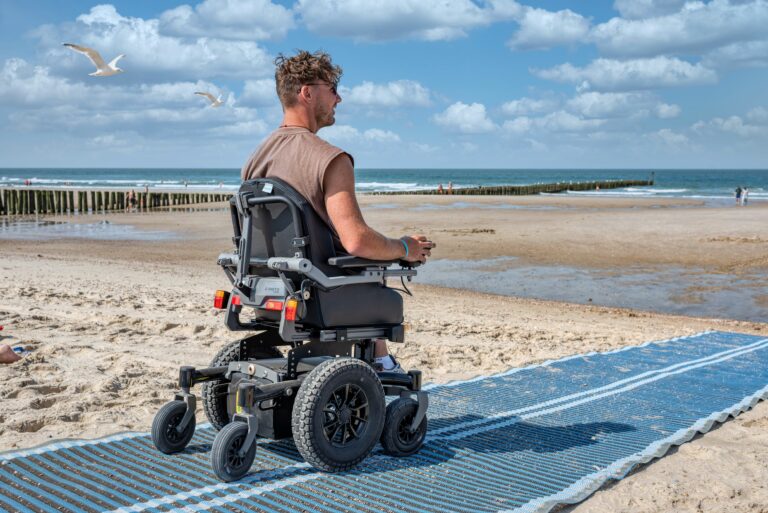Speed can be a significant factor in choosing a power wheelchair. Elsewhere on our blog, we explain the perks of offroad wheelchairs and driving off the pavement. For this reason, some users want an electric wheelchair that runs more quickly. Even though we don’t suggest that the fastest wheelchair is necessarily the best, depending on your needs you may find that the standard model of 4mph (6 km) doesn’t quite cut it for you.
However, before purchasing, it’s vital to understand what the highway code says about powered wheelchairs depending on where you use them. In this article, we’ll explore the vital rules that users need to be aware of before they hit the road (or pavement) at top speed.
What does the Highway Code say about electric wheelchairs?
Electric wheelchairs and mobility scooters are accounted for by the Highway Code. Powered wheelchairs are separated into two classes: Class 2 are those with an upper speed limit of 4 mph (6km/h), designed for driving on pavements. Class 3 encompasses wheelchairs with a top speed limit of 8mph (12 km) and can be used on both road and pavement. Whether operating on the road or pavement, electric wheelchair users are subject to the same guidelines and rules for other vehicles and pedestrians respectively.
Pavement
The code states that “powered wheelchairs and scooters MUST NOT travel faster than 4 mph (6 km/h) on pavements or in pedestrian areas. You may need to reduce your speed to adjust to other pavement users who may not be able to move out of your way quickly enough or where the pavement is too narrow”. Class 3 users must
For moving off the road, the code adds: “always look round and make sure it’s safe to join the traffic. Always try to use dropped kerbs when moving off the pavement, even if this means travelling further to locate one. If you need to climb or descend a curb, always approach it at right angles and don’t try to negotiate a curb higher than the vehicle manufacturer’s recommendations”.
Road
The fastest wheelchair is still a great deal slower than most ordinary traffic. There are several rules in place to ensure all drivers of powered wheelchairs take care when it comes to their speed restrictions and visibility.
Firstly, all Class 3 vehicles must travel in the direction of the traffic (Rule 42). At a top speed of 4mph, Class 2 users are instructed to use the pavement when available, and in the event that there is no pavement, to exercise extreme caution when using the word. Like Class 3, Class 2 must also travel with traffic to avoid confusing lights are mandatory when travelling at night.
Rule 43 of the Highway Code states that all highway code rules regarding lights, indicators and horns — as they apply to other road vehicles — must be followed by wheelchair users. This is because wheelchair users may not be as readily visible to other drivers. Similar to cyclists, this can be helped by wearing a high-vis jacket or including reflective strips on the back of your wheelchair. Wheelchairs must never be used on motorways or unrestricted dual carriageways where the speed limit exceeds 50mph. For other dual carriageways, the vehicle must use a flashing amber beacon for extra visibility.
Parking
When parking an electric wheelchair, users are subject to the same parking restrictions, i.e. vehicles should not be left unattended in case it causes obstruction to other pedestrians, particularly other wheelchair users. The Blue Badge scheme offers parking concessions to those with a valid badge. Parking concessions provided under the Blue Badge scheme (see Further reading) will apply to those vehicles displaying a valid badge.
For further information, a full list of guidelines from the Highway Code can be found on the government’s website.
What’s the top speed a wheelchair can reach?
Speed is determined by a few factors, but the fastest model will be the 8mph electric wheelchair. The ability to reach maximum speed, however, varies depending on the weight of the user (each chair will have a max weight capacity), and so to gain top speed the driver must be lighter than this. Large batteries will also be essential in ensuring that a chair can reach the fastest possible speed.
The terrain being driven on will also affect overall speed. Flat and even surfaces will be more beneficial to those trying to reach top speed, and the tires with the correct pressure will also be a factor that determines how fast an electric wheelchair will go. The chair must also be programmed appropriately depending on outdoor or indoor use.
Our most popular model, the SANGO Advanced, has the option to reach the highest possible powered wheelchair speed of 12.5km/h, along with R-net gyro technology that helps the chair maintain control and direction even at these high speeds. As with all of our electric wheelchairs, it is fitted with a SEGO seating system for comfort and stability, wherever you take it. For more information on choosing your electric wheelchair based on speed, don’t hesitate to get in contact. One of our suppliers will get back to you and answer any queries you may have.



